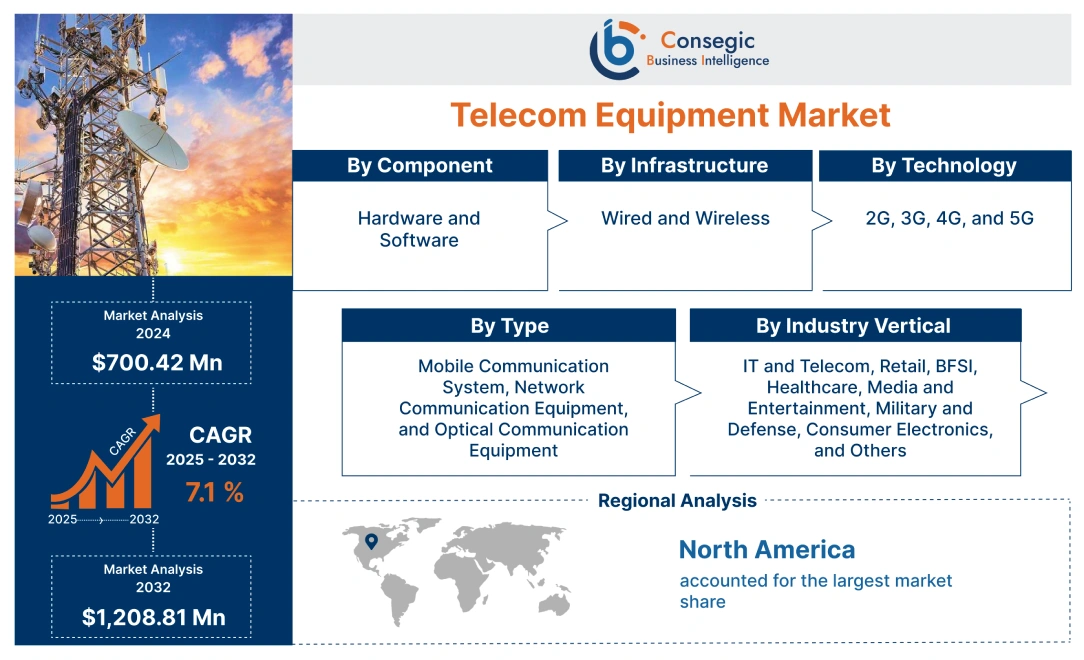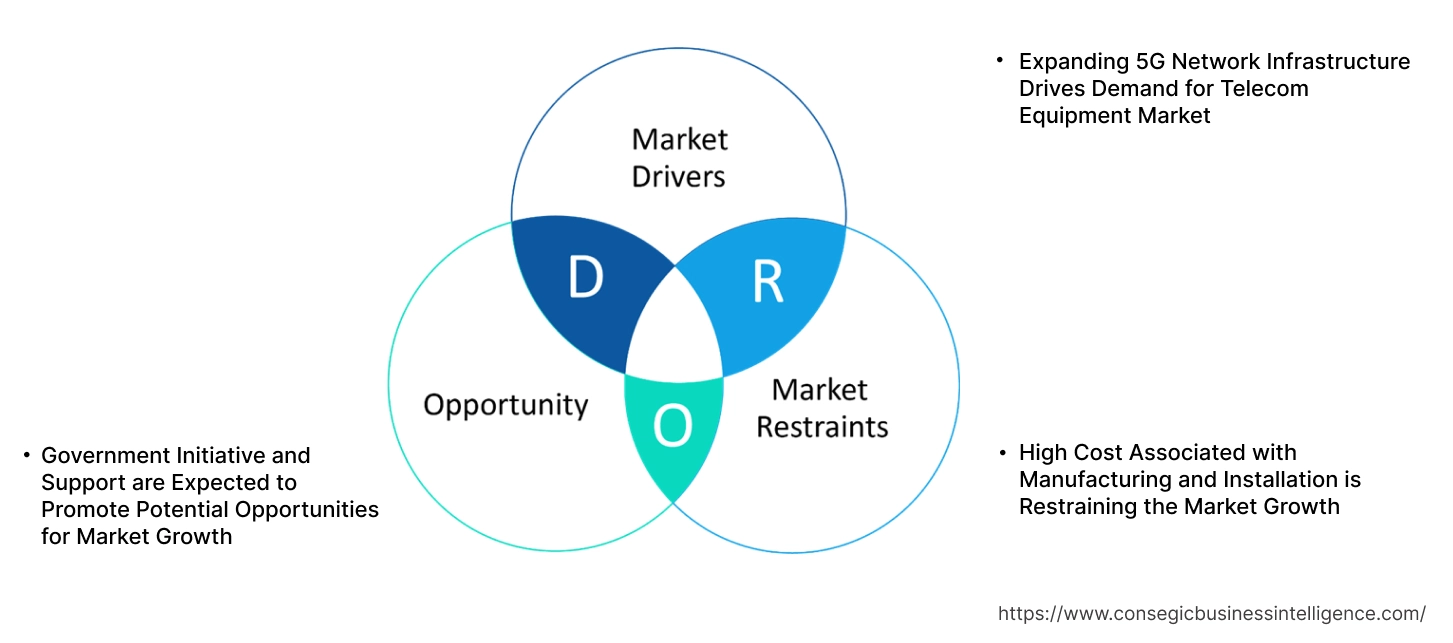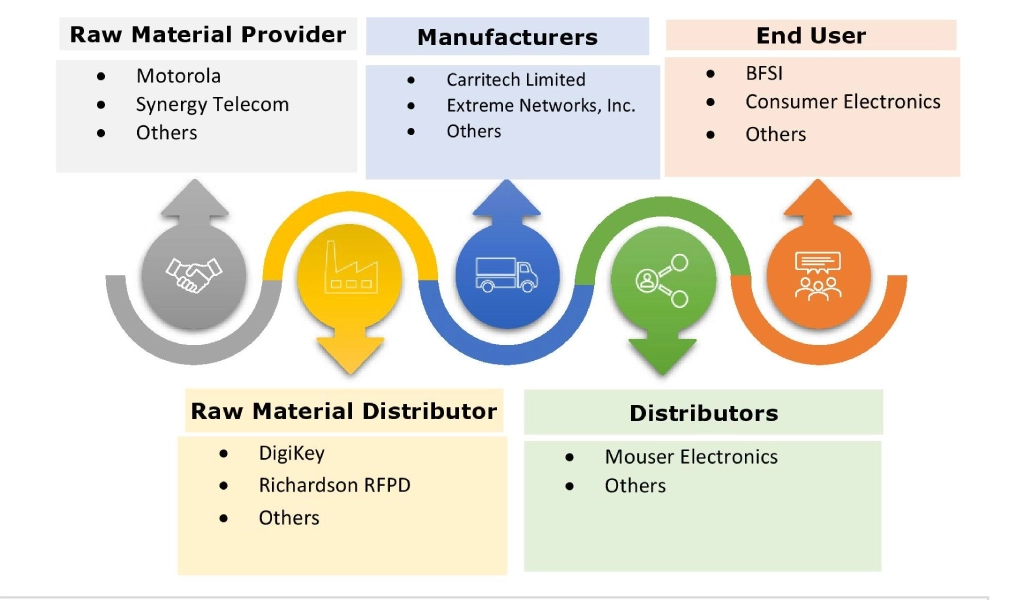Telecom Equipment Market Size :
Telecom Equipment Market size is estimated to reach over USD 1,208.81 Million by 2032 from a value of USD 700.42 Million in 2024 and is projected to grow by USD 737.38 Million in 2025, growing at a CAGR of 7.10% from 2025 to 2032.
Telecom Equipment Industry Definition & Overview:
Telecommunications equipment encompasses the devices and systems that enable communication over distances using electronic signals. The equipment includes various hardware and software components that are crucial for transmitting, receiving, and processing information, facilitating both voice and data communication. Also, the telecom system relies on networks of interconnected nodes and links to enable communication between users, which in turn is driving the telecom equipment market demand. Further, the advancement in modern communications systems is propelling the telecom equipment market growth.
How is AI Impacting the Telecom Equipment Market?
AI algorithms analyze network data to predict potential equipment failures, which in turn enable proactive maintenance and minimize downtime. Also, AI analyzes customer data to provide tailored recommendations for plans, data packs, and others, enhancing customer satisfaction. Additionally, AI facilitates the seamless integration of IoT devices into telecom networks, creating prospects for market growth. Further, AI helps to enhance network security in real-time, minimizing the risk of attacks and data breaches.
Telecom Equipment Market Insights :
Telecom Equipment Market Dynamics - (DRO) :
Key Drivers :
Expanding 5G Network Infrastructure Drives Demand for Telecom Equipment Market
The rapid expansion of 5G network infrastructure is propelling significant investment in upgrading existing networks and deploying new 5G technologies is driving the telecom equipment market growth. Also, the key advancement equipment required, including base stations, antennas, and core network components, is propelling the telecom equipment market demand. Further, the rising need for faster speeds, lower latency, and the ability to handle massive device connectivity that 5G offers is boosting the telecom equipment industry.
- For instance, according to the India brand equity foundation (IBEF), India’s 5G subscriber base reached 290 million in 2024, as well as average 5G data consumption has increased to 40 Gigabytes (GB) per user per month is driving the demand for equipment.
Therefore, the expanding 5G network infrastructure is driving the demand for equipment, in turn proliferating the growth of the market.
Key Restraints :
High Cost Associated with Manufacturing and Installation is Restraining the Market Growth
The equipment involves significant capital investments in production facilities, research and development, and advanced technologies, which in turn are hindering the telecom equipment market expansion. Additionally, the equipment installation, network integration, and ongoing maintenance incur high upfront costs, which in turn hinder market adoption. Further, the advanced telecom technologies such as 5G incur huge costs, restraining the telecom operators from expanding.
Therefore, the high costs of manufacturing and installation are hindering the telecom equipment market expansion.
Future Opportunities :
Government Initiative and Support are Expected to Promote Potential Opportunities for Market Growth
Government initiatives and support are expected to significantly boost the market by providing schemes such as the production-linked incentive (PLI) scheme, the national digital communications policy (NDCP), and the BharatNet project, among others. Additionally, the rising focus on creating a robust digital communications infrastructure aims to provide high-speed broadband, is propelling the telecom equipment market opportunities.
- For instance, in July 2024, according to the Indian Ministry of Communications, the production-linked incentive (PLI) scheme for telecom and networking productshas led to a significant increase in production. Additionally, the telecom equipment production reached USD 5699.6 million.
Hence, the rising government support is anticipated to increase the utilization of equipment, in turn promoting prospects for telecom equipment market opportunities during the forecast period.
Telecom Equipment Market Segmental Analysis :
By Component :
Based on the Component, the market is bifurcated into hardware and software.
Trends in the Component:
- The growing number of connected devices (IoT) is driving the need for software components, which in turn is boosting the telecom equipment market trends.
- The growing focus on designing energy-efficient and environmentally friendly telecom infrastructure is driving the adoption of hardware components, which in turn is boosting the telecom equipment market trends.
Hardware accounted for the largest revenue share in the year 2024.
- The hardware component includes IP intercom hardware, servers, and storage hardware, among others.
- Hardware components are essential for facilitating the transmission of multimedia communications and voice-over-data, which in turn fuels the telecom equipment market share.
- Additionally, the components are essential for optimizing large volumes of data, ensuring low latency, and delivering consistent connectivity which is fueling the telecom equipment market share.
- For instance, in June 2023, ventureLAB launched a hardware angel network designed to deliver high-quality data connectivity to users, low latency to users, improve the telecom infrastructure, and others.
- Thus, according to the telecom equipment market analysis, the ability to optimize large volumes of data, for ensuring low latency, is driving the market progress.
Software is anticipated to register the fastest CAGR during the forecast period.
- The shift from traditional hardware-based solutions to software-based virtualized networks boosts the telecom equipment market size.
- Additionally, the key advantages of software components include flexibility, scalability, and cost-efficiency boost the telecom equipment market size.
- Further, the increasing focus on reducing costs and increasing agility is driving the adoption of software components.
- Therefore, as per the market analysis, the aforementioned factors are anticipated to boost the market during the forecast period.
By Type :
Based on the type, the market is segmented into mobile communication system, network communication equipment, and optical communication equipment.
Trends in the Type:
- The rising popularity of open radio access networks is driving the adoption of mobile communication system, which in turn is boosting the market trends.
- The trend towards the development of AI-powered network equipment to optimize network performance, automate tasks, and others is boosting the market progress.
The network communication equipment accounted for the largest revenue share of 41.4% in the year 2024.
- Network communication equipment includes gateways, routers, switches, access points, and other devices designed to enable the switching, routing, and transmission of data within networks.
- Additionally, the network communication equipment is essential for establishing and managing communication pathways, which in turn enables data transfer across various network nodes.
- Further, the network communication equipment facilitates voice communication, video streaming, internet access, and cloud services, among others, which in turn drives the need for communication equipment.
- Thus, according to the telecom equipment market analysis, the aforementioned factors are driving the market progress.
The mobile communication system is anticipated to register the fastest CAGR during the forecast period.
- The rising number of mobile subscribers worldwide, as well as expanding mobile networks, is boosting the market progress.
- Additionally, the rising internet penetration is driving the need for mobile communication systems due to a surge of mobile data traffic, fueled by video streaming, contributing to the market progress.
- Further, the edge computing integration and AI-powered network optimization are driving the demand for mobile communication systems.
- For instance, in September 2022, Huawei launched the future railway mobile communication system (FRMCS) to reshape the digital platform for the development of a secure, efficient, and smarter railway communications network.
- Therefore, as per the market analysis, the rising internet penetration is anticipated to boost the market during the forecast period.
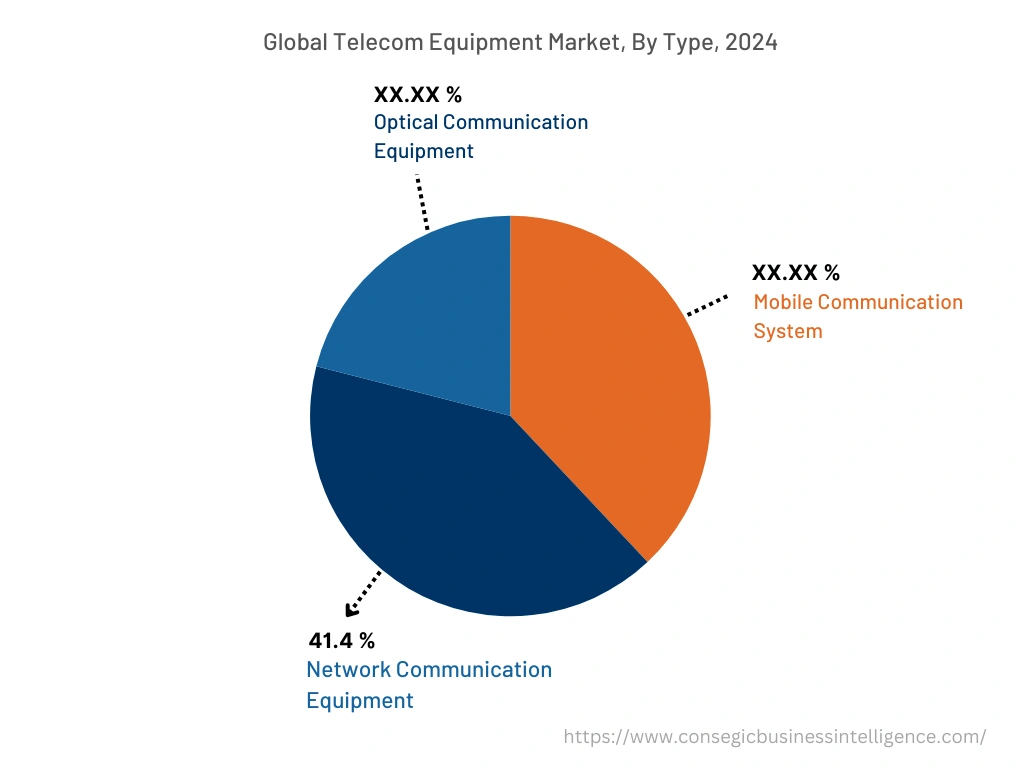
By Infrastructure :
Based on the infrastructure, the market is bifurcated into wired and wireless.
Trends in the Infrastructure:
- The trend towards the development of Wi-Fi 6E and 6G network technology is driving the adoption of wireless infrastructure.
- The trend towards the increasing demand for high-speed internet and data services is driving the adoption of wired infrastructure.
Wireless accounted for the largest revenue share in the year 2024 and is anticipated to register the fastest CAGR during the forecast period.
- The proliferation of IoT devices across various sectors is driving demand for infrastructure with capabilities to handle the increased data volume and bandwidth requirements.
- Additionally, the increasing consumption of mobile data for streaming, social media, and other applications to ensure sufficient capacity and speed is driving the market progress.
- Further, the wireless communication plays a crucial role in defense and aerospace to provide secure and reliable networks is driving the need for wireless infrastructure.
- Thus, as per the market analysis, the rising adoption by the defense and aerospace industry is driving the market progress.
By Technology :
Based on the technology, the market is segmented into 2G, 3G, 4G, and 5G.
Trends in the Technology:
- The widespread adoption of smartphones, smartwatches, tablets, and other connected devices is driving the need for 5G technology, which in turn is driving the market trends.
- The expansion of cloud-native infrastructure is driving the need for 4G technology, which in turn is driving the market trends.
4G accounted for the largest revenue share in the year 2024.
- The increasing demand for high-speed internet, due to the proliferation of smart devices, is driving the adoption of 4G technology.
- Additionally, the globally recognized standards, including long-term evolution (LTE), are driving the adoption of 4G technology.
- Further, the key factor driving the adoption of 4G technology is due to improved network capacity, allowing more connections and better handling of high data traffic.
- Thus, as per the market analysis, the aforementioned factor is driving the market progress.
5G is anticipated to register the fastest CAGR during the forecast period.
- The increasing investments by the government to initiate 5G services to promote digitalization in various sectors are boosting the market progress.
- Additionally, the rising need for massive MIMO to support a larger number of devices simultaneously is driving the evolution of 5G technology.
- Further, the increasing investments by the government to initiate 5G services to promote digital infrastructure are boosting the 5G technology.
- For instance, in April 2023, the government of the United Kingdom invested approximately USD 44.02 million to boost the 5G infrastructure, aiming to enhance the digital infrastructure by 2030.
- Therefore, as per the market analysis, the increasing investments by the government are anticipated to boost the market during the forecast period.
By Industry Vertical :
Based on the industry vertical, the market is segmented into IT and telecom, retail, BFSI, healthcare, media and entertainment, military and defense, consumer electronics, and others.
Trends in the Industry Vertical:
- The increasing cybersecurity threats are driving the need for robust security measures, which in turn is driving the adoption by the IT and telecom sector.
- The rising adoption of smart home devices and wearables is driving the need for seamless network connectivity in turn driving the market evolution.
Consumer Electronics accounted for the largest revenue share in the year 2024.
- The proliferation of IoT devices and smart home technologies is driving the need for network communication systems.
- Additionally, the rising popularity of streaming platforms drives the need for high-speed internet and reliable telecom networks.
- Further, the deployment of 5G networks to meet the demands of new technologies and applications is driving the market progress.
- For instance, according to the India Brand Equity Foundation (IBEF), the consumer electronics sector accounted for USD 9.84 billion in 2021 and is expected to reach USD 21.18 billion in 2025.
- Thus, as per the market analysis, the proliferation of IoT devices and smart home technologies is driving the market progress.
The IT and telecom sector is anticipated to register the fastest CAGR during the forecast period.
- The growing number of mobile phone users worldwide necessitates investments in network infrastructure.
- Additionally, the increasing demand for high-speed internet connectivity and the expansion of digital infrastructure are driving the market adoption by the IT and telecom sector.
- Further, the rise of cloud computing as well as artificial intelligence, and automation is driving the market adoption in IT and telecom to optimize network performance, enhance cybersecurity, and improve customer service.
- Therefore, as per the market analysis, the rise of cloud computing, as well as artificial intelligence and automation, is anticipated to boost the market during the forecast period.
Based on the Region :
The regions covered are North America, Europe, Asia Pacific, Middle East and Africa, and Latin America.
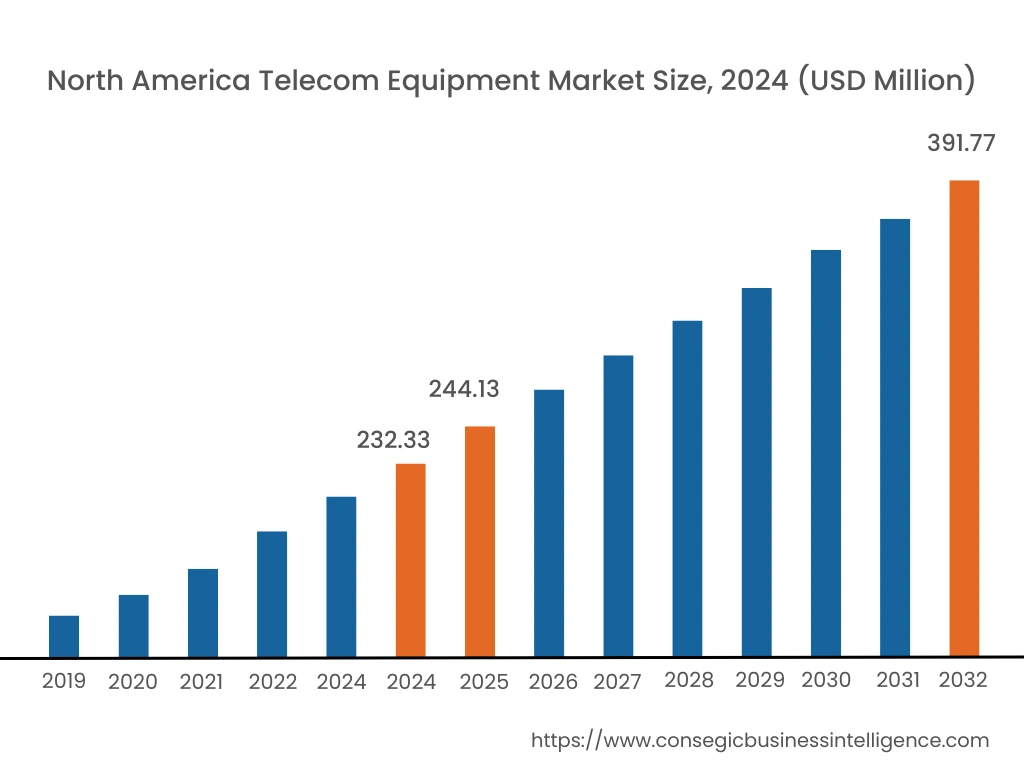
Asia Pacific is expected to register the fastest CAGR of 7.5% during the forecast period in the telecom equipment market. The market progress is mainly driven by rising government initiatives to promote digitalization. Furthermore, factors including the rising smart city projects and 5G development, as well as the evolution of e-commerce and digital services in the Asia Pacific, are projected to drive the market progress in the Asia Pacific region during the forecast period.
- For instance, according to IBEF, in the 2023 festival season, Indian e-commerce platforms' gross merchandise value reached USD 5.67 billion, which in turn is fueling the market progress.
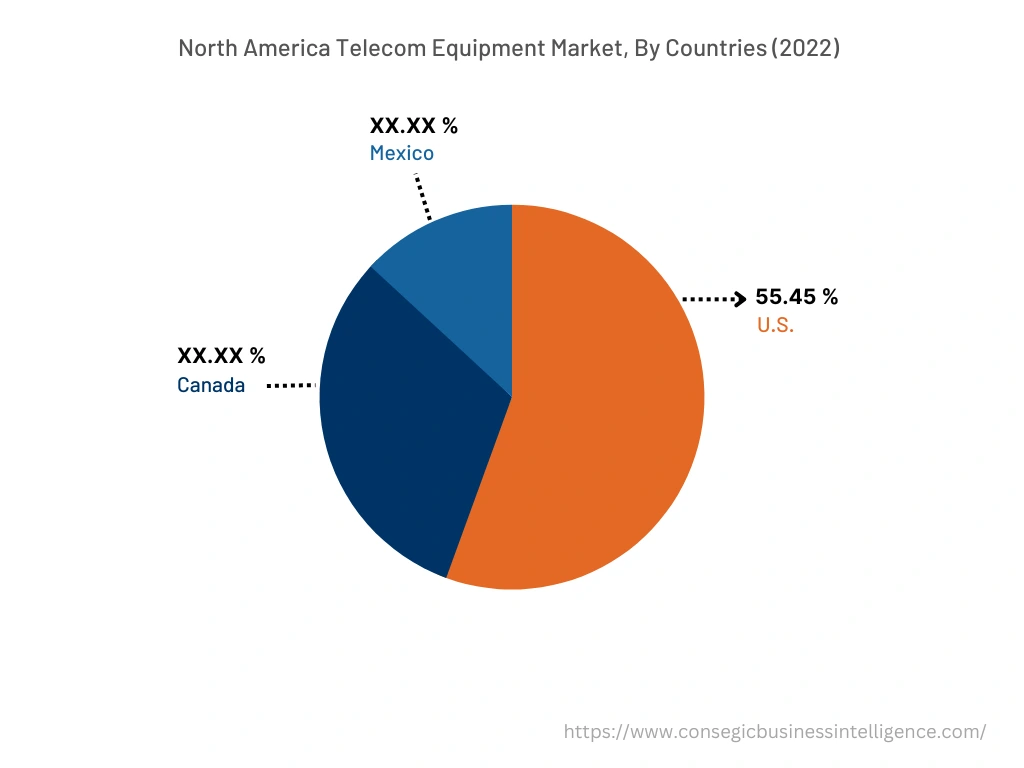
North America is estimated to reach over USD 391.77 Million by 2032 from a value of USD 232.33 Million in 2024 and is projected to grow by USD 244.13 Million in 2025. In addition, in the region, the U.S. accounted for the maximum revenue share of 55.45% in the year 2024. The North American region's rapid deployment of 5G infrastructure and the increasing demand for high-speed data services offer lucrative growth prospects for the market. Additionally, the proliferation of IoT devices, as well as the integration of edge computing and enhanced cybersecurity measures, is driving the market progress.
- For instance, in April 2021, the Department of Defense partnered with the National Science Foundation with an investment of USD 40 million for the expansion of cellular, Wi-Fi, and satellite networks across the United States.
The regional analysis depicts that the rising adoption of private 5G networks and the increasing focus on network slicing solutions are driving the market in Europe. Additionally, the key factor driving the market is the rapid adoption of digital solutions, the rising need for sustainable solutions, and investments in infrastructure are propelling the market adoption in the Middle East and African region. Further, the expansion of 5G networks and rising adoption of fiber optic technology are paving the way for the progress of the market in the Latin America region.
Top Key Players & Market Share Insights :
The global telecom equipment market is highly competitive with major players providing telecom equipment to the national and international markets. Key players are adopting several strategies in research and development (R&D), product innovation, and end user launches to hold a strong position in the telecom equipment industry. Key players in the telecom equipment market include-
- Carritech Limited(UK)
- Extreme Networks, Inc.(USA)
- NEC Corporation (Japan)
- Nokia Corporation (Finland)
- Qualcomm TechCompany, Inc. (USA)
- FiberHome Technologies(China)
- Fujitsu Limited (Japan)
- Huawei Technologies Co. Ltd (China)
- Juniper Networks, Inc. (USA)
- Rakuten Mobile, Inc. (Japan)
Recent Industry Developments :
Product launches
- In March 2025, Viettel Group launched a 5G equipment trial with Emirates Integrated Telecommunications Company PJSCin the Middle East. The launch aims to promote the development, testing, and commercialization of 5G solutions across the Middle East.
Telecom Equipment Market Report Insights :
| Report Attributes | Report Details |
| Study Timeline | 2019-2032 |
| Market Size in 2032 | USD 1,208.81 Million |
| CAGR (2025-2032) | 7.10% |
| By Component |
|
| By Type |
|
| By Infrastructure |
|
| By Technology |
|
| By Industry Vertical |
|
| By Region |
|
| Key Players |
|
Key Questions Answered in the Report
How big is the telecom equipment market? +
The telecom equipment market size is estimated to reach over USD 1,208.81 Million by 2032 from a value of USD 700.42 Million in 2024 and is projected to grow by USD 737.38 Million in 2025, growing at a CAGR of 7.10% from 2025 to 2032.
Which segmentation details are covered in the telecom equipment report? +
The telecom equipment report includes specific segmentation details for component, type, infrastructure, technology, industry vertical, and regions.
What are the key trends in the telecom equipment market? +
The telecom equipment market is being shaped by several key trends including the rising popularity of open radio access networks which is driving the adoption of mobile communication systems, as well as a growing focus on designing energy-efficient and environmentally friendly telecom infrastructure and other.
Which is the fastest segment anticipated to impact the market growth? +
In the telecom equipment market, the IT and telecom sector is the fastest-growing segment during the forecast period due to the rise of cloud computing, as well as artificial intelligence and automation.
Who are the major players in the telecom equipment market? +
The key participants in the telecom equipment market are Carritech Limited (UK), Extreme Networks, Inc. (USA), FiberHome Technologies (China), Fujitsu Limited (Japan), Huawei Technologies Co. Ltd (China), Juniper Networks, Inc. (USA), Rakuten Mobile, Inc. (Japan), NEC Corporation (Japan), Nokia Corporation (Finland), Qualcomm TechCompany, Inc. (USA), and others.
